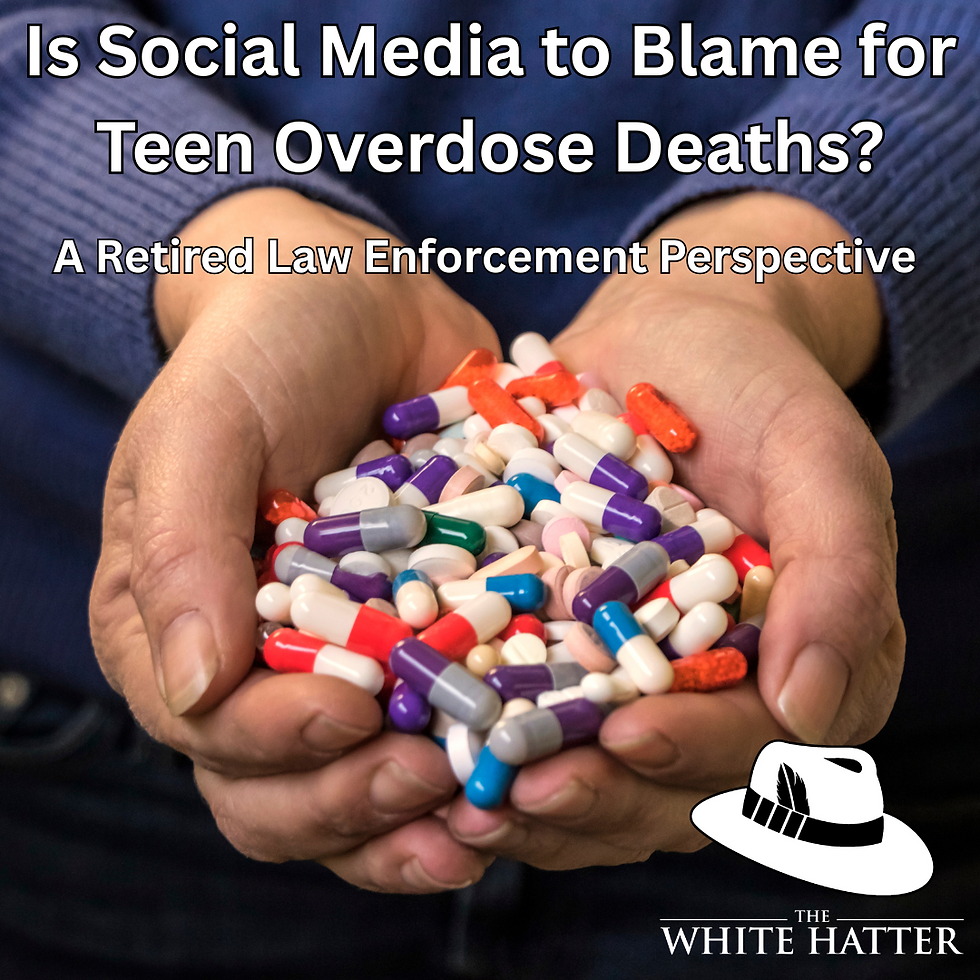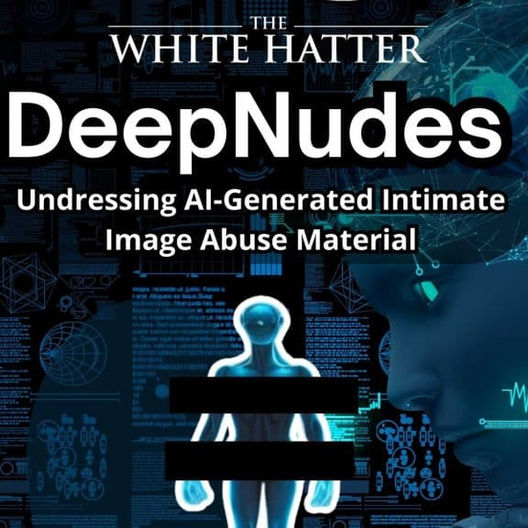Is Social Media to Blame for Teen Overdose Deaths? A Retired Law Enforcement Perspective
- The White Hatter

- Jul 17
- 5 min read

CAVEAT - We were recently asked by a follower for our thoughts on a growing claim that social media platforms used to sell or arrange the sale of drugs to teens are directly to blame for teen overdose deaths. It’s a politically charged question, and we know not everyone will agree with our perspective.
When a teen dies from a drug overdose, it’s devastating. As parents, our first instinct is to look for answers such as, “what caused this?” or “Who’s responsible” In recent years, much of the blame has been placed by some on technology and social media. But the reality is more complicated.
Over Darren’s nearly 30-year career in law enforcement, most of it focused on street-level drug enforcement, he witnessed the tragic impact of drugs and addiction on youth firsthand. Darren started policing in 1987 and retired in 2016, and in that time, he made thousands of drug-related arrests and responded to more than a few fatal overdoses, including those involving youth under the age of 18. What has changed today are the types of “recreational” drugs youth and teens are turning to, especially when it comes to the abuse of prescription pills such as Percocet (perks or blues) or Xanax, and how teen pop culture, especially when it comes to “some” of the music they listen to, pushes the message of recreational drug use of these same drugs.
To understand where we are now, it helps to look back at how access to drugs has evolved, and how “some” teens have always found ways to get them.
In the 1980s, teens typically bought drugs from peers or traveled downtown to meet a dealer, often at arcades or youth and teen hangout spots.
By the 1990s, the pager era had arrived. Teens would call a number, leave a message, and then meet the dealer at a pre-arranged spot. This is where the term “dial-a-dealer” came from.
In the early 2000s, pagers were replaced by more affordable and widespread cellphone use, and drug deals began happening via voice calls and texts.
In 2011, Snapchat (originally called Peekaboo) became a popular way for teens to message dealers with little traceability. With the advent of SnapMaps, dealers could now meet you at your exact location. The birth of the “text-a-dealer” or “dm-a-doper” was born (1)
By 2013, the Dark Web, and sites like “Silk Road” made it possible for tech-savvy teens to order drugs anonymously and have them delivered right to their door.
Today, there is an abundance of social media platforms and messaging apps that are being used to sell and purchased illegal drugs. (2)
The through-line here is clear, access has always existed. What’s changed is how easy and private that access has become. Technology hasn’t created the desire to use drugs or made them more dangerous, it’s simply removed some of the barriers and risks involved in getting them. The same way pagers and cellphones once made access easier, today, social media and encrypted apps do the same.
According to the U.S. National Institute on Drug Abuse, before Facebook even launched in 2004, overdose deaths among youth aged 15 to 24 ranged from 600 to 1,500 deaths per year. (3) This was long before the rise of TikTok, Snapchat, and Instagram. Clearly, teen drug use and overdoses are not new problems created by modern technology. Today, these types of overdose deaths have nearly tripled—not because of social media, but due to the surge in Fentanyl and other synthetic opioids that frequently contaminate the current illegal drug supply.
However, that doesn’t mean technology plays no role. Social media and encrypted messaging platforms have contributed to the problem by making it easier, faster, and more discreet for youth to connect with dealers. This makes these platforms a gateway, not unlike the arcade in the 1980s or the use of pagers or a burner phone in the early 2000s. The difference now is the 24/7 constant access, the types of drugs available, the anonymity, and the reduced risk of being caught because of technology.
That’s why we believe social media platforms must take more responsibility. They should be “proactively” monitoring for illegal drug sales, and they have the ability to do this. If they’re “reactively” notified that someone is dealing drugs on their platform and choose to do nothing, that’s willful blindness, and they should be held legally accountable. Stronger federal laws are needed to enforce this, with real consequences if companies ignore the issue.
Still, it’s important for parents and caregivers to understand this key point, social media is not the cause of overdose deaths. Is it a contributing factor, yes, but not the root cause. Blaming tech may feel satisfying, but it oversimplifies the issue. Drug addiction, trauma, mental health struggles, risk taking, and the deadly presence of synthetic opioids like fentanyl are all part of a much larger picture when it comes to drug overdose deaths.
Fentanyl is a synthetic opioid that is about 50 times stronger than heroin and one hundred times stronger than morphine and even the slightest amount can cause death. It is true that the number of teen overdose deaths has increased dramatically since the early 2000’s because of fentanyl. It is also important to know that if fentanyl doesn’t kill you, it can quickly lead to addiction, which can often lead to death.
Many parents and caregivers believe that youth and teens will only encounter fentanyl if they are doing “hard drugs”. However, many teen overdose drug deaths occur after taking what they thought were a prescription drug that they purchased online, such as Adderall (which is unknowingly laced with fentanyl) which some teens will use to improve focus and self-regulation. Teens misuse Adderall to help them stay awake, concentrate longer, or cram for exams. It’s often dubbed a “study drug” for this reason.
So what can parents and caregivers do?
Stay informed about how teens are accessing drugs today. (4)
Talk openly with your kids about substance use and the risks involved, especially given the risks of fentanyl contamination.
When it comes to pills, youth and teens need to understand that unless a medication was prescribed specifically for them by their own doctor, they should never take it, no matter who it comes from, even a close friend. There’s a high chance that pill could be counterfeit and laced with fentanyl. Just one pill can be deadly, and increasingly we’re seeing young lives lost because of it.
Advocate for stronger regulations on platforms that enable illegal drug sales activity.
We also believe that given the increase in fentanyl deaths, basic first aid training, for both teens and adults, should now also include how to administer Naloxone. (5) Naloxone should also be made available in every first aid kit in the home, school, workplace, or public gathering spaces.
Technology plays a role, but it’s not the whole picture. Even if you manage to keep your youth or teen off social media or away from a cellphone, there are still plenty of other ways they can access illegal drugs, especially now, in the midst of a synthetic opioid crisis. If we truly want to protect young people, we need to take a wider view and respond with that reality in mind, and yes, that includes holding social media platforms accountable for allowing the sales of drugs on their platforms.
Digital Food For Thought
The White Hatter
Facts Not Fear, Facts Not Emotions, Enlighten Not Frighten, Know Tech Not No Tech
References:














